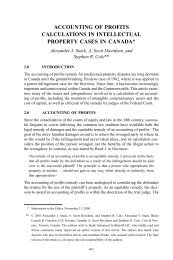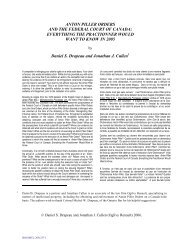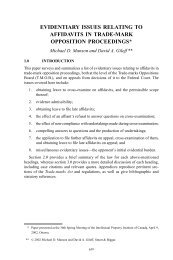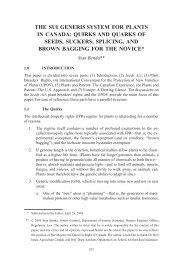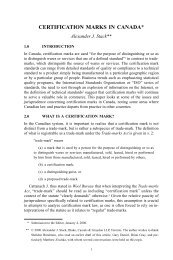A Comparative Overview of Canadian, US and European ...
A Comparative Overview of Canadian, US and European ...
A Comparative Overview of Canadian, US and European ...
You also want an ePaper? Increase the reach of your titles
YUMPU automatically turns print PDFs into web optimized ePapers that Google loves.
I. General Issues 1<br />
Canada United States Europe<br />
Patent law is national (subject to certain regional treaties: see the discussion <strong>of</strong> Europe, below), but the Agreement on Trade-Related Aspects<br />
<strong>of</strong> Intellectual Property Rights (TRIPS) has harmonized the law at the general level. Generally, patents are available (with some specified<br />
exceptions) for inventive products or processes in all fields <strong>of</strong> technology so long as the invention is new, involves an inventive step <strong>and</strong> is<br />
useful (or, equivalently, is capable <strong>of</strong> industrial application). The TRIPS agreement requires that patents shall be enjoyable without<br />
discrimination as to the place <strong>of</strong> making the invention, the field <strong>of</strong> technology <strong>and</strong> whether products are imported or locally produced (TRIPS,<br />
Article 27).<br />
Patentees will normally wish to patent an important invention in more than one country. International treaties to which Canada is signatory<br />
facilitate this by allowing a patent applicant in one country to base its application on <strong>and</strong> “claim priority” from an earlier filing in another country,<br />
so long as the second application is filed within one year <strong>of</strong> the first. The country in which the patent application is originally filed is referred to<br />
as the country <strong>of</strong> first filing, <strong>and</strong> the country in which a subsequent application is filed which claims priority to the first, is referred to as the<br />
country <strong>of</strong> second filing. Generally, Canada is a country <strong>of</strong> second filing, in that most <strong>Canadian</strong> patent applications claim priority from a first<br />
filing in another country, particularly the <strong>US</strong> or Europe. The various national patents based on a single application are referred to as a patent<br />
family. Even though a single original application may be the basis for a patent in several different countries, the application must be pursued<br />
(prosecuted) separately in each country <strong>and</strong> amendments to an application, especially amendments to the claims, are common. Consequently,<br />
each national patent in a single patent family may have a different scope <strong>of</strong> protection for an invention <strong>and</strong> individual patents issued within the<br />
same patent family are <strong>of</strong>ten slightly different at a detailed level.<br />
Legislation <strong>Canadian</strong> law is found primarily in the<br />
Patent Act, as interpreted by the courts.<br />
The Act was significantly amended by<br />
RSC 1985 c 33 (3rd Supp), <strong>and</strong> the Act as<br />
amended applies to patents which were<br />
applied for after 1 Oct 1989. The amended<br />
Act is <strong>of</strong>ten referred to as the “new Act”.<br />
One <strong>of</strong> the major changes implemented by<br />
the new Act was to move from a first-toinvent<br />
to a first-to-file system (see below).<br />
While some “Old Act” patents are still in<br />
effect, this comparison will focus on the<br />
new Act.<br />
<strong>US</strong> law is found primarily in title 35 <strong>of</strong> the <strong>US</strong><br />
Code, as interpreted by the courts. The<br />
America Invents Act significantly amends the<br />
35 <strong>US</strong>C. The AIA was signed into law on<br />
September 16, 2011. One <strong>of</strong> the major<br />
changes implemented by the AIA was to move<br />
from a first-to-invent to a first-inventor-to-file<br />
system (see below). While not all <strong>of</strong> the<br />
provisions <strong>of</strong> the AIA have yet come into<br />
effect, this comparison will focus on <strong>US</strong> law as<br />
amended by the AIA, as that reflects current<br />
<strong>US</strong> thinking <strong>and</strong> will soon reflect <strong>US</strong> law.<br />
<strong>European</strong> law is a hybrid system based on the<br />
<strong>European</strong> Patent Convention (EPC). The EPC<br />
sets out substantive law, similar to our Patent<br />
Act, <strong>and</strong> also sets up the framework for the<br />
administration <strong>of</strong> the EPC. Under the EPC<br />
system, patents are examined <strong>and</strong> granted<br />
centrally, by the <strong>European</strong> Patent Office<br />
(EPO), according to the law set out in the<br />
EPC. Patents granted by the EPO are<br />
commonly referred to as <strong>European</strong> patents,<br />
though it should be noted that membership <strong>of</strong><br />
the EPC is not co-extensive with the <strong>European</strong><br />
Union. All members <strong>of</strong> the <strong>European</strong> Union are<br />
also members <strong>of</strong> the EPC, but there are<br />
several countries that are members <strong>of</strong> the<br />
EPC but which are not members <strong>of</strong> the EU.<br />
Once granted, a <strong>European</strong> patent is only<br />
enforceable according to national law <strong>of</strong> an<br />
EPC country in which the patent has been<br />
validated. For example, if a patentee believes<br />
someone is infringing its patent in both the UK<br />
<strong>and</strong> Germany, it will have to sue in both<br />
countries. While national patent law <strong>of</strong> all EPC<br />
countries has been harmonized with the EPC,<br />
This is a brief <strong>and</strong> very simplified summary <strong>of</strong> selected aspects <strong>of</strong> the three patent systems. It is intended for general informational purposes <strong>and</strong> should not be<br />
used as a basis for taking decisions with regards to any specific cases. Qualified advice should be sought regarding any specific fact situations. All references<br />
to CETA are based on our underst<strong>and</strong>ing <strong>of</strong> the provisions <strong>of</strong> CETA, as determined from sources available on the Internet. IPIC ©2012<br />
5/24



